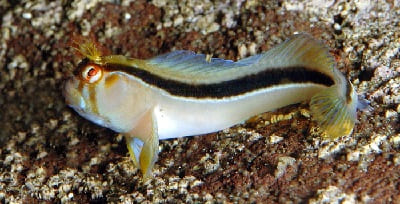Home › Sea Creatures › Marine Animals › Vertebrate › Blennies
Blenny Fish Facts and Information
[Phylum: Chordata] [Class: Actinopterygii] [Order: Blenniiformes] [Family: Blenniidae]
One feature that distinguishes the numerous species of blennies fish is the single dorsal fin that runs from the back of the head to the tail.
This section contains fun facts and interesting information about the blenny fish, such as where to find them, what they eat, and how they reproduce.
Blennies Common Habitats and Distribution
Living inside the crevices of rocky pools and reefs are the typical places to find these small bottom-dwellers.
They inhabit the shallow water environments of the Atlantic and Pacific oceans. But, some species can survive at depths around 450 metres.
Here's the thing:
Being a hardy fish means you will find them in most temperate regions as well as some cold water ecosystems.
Scientists use the various fin formations to identify different groupings.
Blenny fish are mostly a benthic species, spending a lot of time scurrying around the ocean floor. Nonetheless, the sabre-toothed blenny (Aspidontus taeniatus) is known for spending more time 'mid-water' hunting for food.
Blenny Fish Behaviour
Almost all types of blennies fish are reclusive creatures. They make burrows in the sandy substrate (e.g. sand and mud) and they hide inside the crevices of rocky reefs.
In fact, some blenny fish species actually live inside unoccupied shells of large mollusks. Hence, it's not unusual to find a female nesting inside an empty clam shell or oyster shell.
Some of the most common blenny types that have spiny fins, scaleless skin, and a large blunt head, and include:
- Brown coral blenny fish
 Combtooth blenny
Combtooth blenny- Crested blenny
- Diamond blenny
- Hairy blenny fish (Labrisomus nuchipinnis)
- Lawnmower blenny
- Midas blenny (one of the largest blennies)
- Striped blenny
- Tailspot blenny
- Twinspot blenny
Most of the blennioid species of fishes are completely carnivorous (e.g. Clinid). But, the herbivorous specimens will display algae-grazing behaviour. This is one reason why people keep blennies in an aquarium. In fact, some of the blenny species are detritivores (e.g. they consume detritus)
Another reason why aquarists keep blennies in captivity is because they are a relatively small marine fish. In fact, most will grow no bigger than thirteen (13) centimetres in length (5 inches).
The elongated dorsal fin has short spines and the pelvic fins are located close to the esophagus (area at the back of the throat).
What Does a Blenny Eat?
Much like the goby fish family, the vast majority of the blennies species eat tiny crustaceans (e.g. Mysida) with a combination of small mollusks and various planktonic organisms.
Courtship Behaviour of Blennies
For the most part, the adult male blenny will grow larger than the female. Plus, they all tend to change their base colouring according to the local habitat.
Colour changing also occurs during the mating season - either through excitement or to make themselves appear more attractive!
Fun Fact: The flame tail blenny (Ecsenius bicolor) is considered as being the 'cutest' because it displays a brown and yellowish orange colouring. This species is seen most often in marine aquariums darting about and generally being a little aggressive with other species.
Related Information and Help Guides
- Cardinal Fish Facts and Species Information
- Flashlight Fish Fun Facts and Information
- Goby Fish Facts and Interesting Information
- Marine Vertebrates with Examples and Pictures
- Wrasse Fish Species Interesting Information
Note: The short video [6:47 seconds] presented by 'Aquarium Fish Keepers' explains how to choose the right blenny fish for a pet and then how to take care of it when it's living in a fish tank.